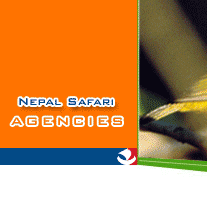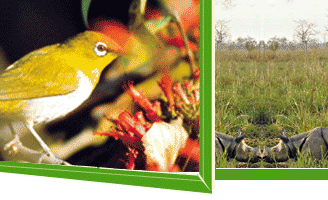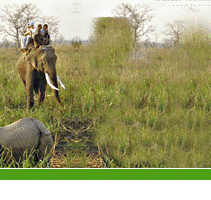Royal Chitwan National Park:
This is one of the most popular national parks in Nepal. The park is situated in the sub-tropical lowlands of southern Nepal, lying between two mountain ranges, the Shivalik and the Mahabharat range.
This is the flood plain of three rivers, the Rapti, the Reu and the Narayani. The forest is dominated by Sal trees (shorea robusta) and tall grasses.
This is the natural habitat of endangered animals like Bengal tigers, one-horned rhinoceros, gharial crocodile, gaur (the world's largest wild cattle), four species of deer, leopards, wild dogs, fishing cats, leopard cats, python and Gangetic dolphin. There are over 50 species of mammals and 450 species of birds in the park.
Before 1950, this area used to be the hunting reserve for the ruling class of Nepal. The hereditary prime ministers of the Rana family, who ruled Nepal for 104 years, often used to invite people from England and India as their guests and huge numbers of tigers and rhinos were killed.
Today the tourists can ride elephants and view the wild animals at close range.
Sagarmatha National Park:
This is the highest national park in the world, with the entire park located above 3,000 m ( 9,700 ft). This park includes three peaks higher than 8,000 m, including Mt Everest.
With its terrain cut by deep rivers and glaciers, this park can be divided into four climate zones
- A forested lower zone,
- A zone of alpine scrub,
- The upper alpine zone which includes upper limit of vegetation growth,
- The Arctic zone where no plants can grow.
In the lower forested zone, birch, juniper, blue pines, firs, bamboo and rhododendron grow.
Above this zone all vegetation are found to be dwarf or shrubs.
As the altitude increases, plant life is restricted to lichens and mosses.
Plants cease to grow at about 5,750 m (18,690 ft), because this is the permanent snow line in the Himalayas.
The Sagarmatha National Park is one of the most beautiful places on the Earth, especially in summer. After the first monsoon rains in June, the hillsides become green and different varieties of flowers start blooming, and butterflies of myriad species appear in different colors.
118 species of birds and 26 species of butterflies have made this park their home.
Some of the endangered animals that are found in this park are musk deer, wild yak, red panda, snow leopard and Himalayan black bear. Many other animals such as Himalayan thars, deer, langur monkeys, hares, mountain foxes, martens, and Himalayan wolves are living here.
The oxygen gets thinner with the altitude. Therefore, the animals here are adapted to living on less oxygen as well as a cold temperature. They have thick coats or shortened limbs to prevent loss of body heat. The Himalayan bears go into hibernation in caves during the winter when there is no food available.
Langtang National Park:
Located about 32 km (20 miles) north of Kathmandu, this park consists of the beautiful Langtang Valley, and several high altitude glacial lakes. One of the famous lakes is Gosainkunda, which is a sacred lake for Hindu pilgrims. People from the plains come every year to bathe in this icy cold lake in August. This park also includes more than 40 villages.
Rara National Park:
From the east, the high pass of Bul-Bhulei (12,000 ft) forms the gateway to the Rara National Park. Rara is one of the favourite National Parks of Nepal, spread out over 44 square kilometers.
This park is named after a lake called Rara. This is one the biggest lakes in Nepal, covering an area of about 15 square kilometers at an elevation of 2,990 m ( 9,717 ft). The Rara Lake, formed on a plateau, is surrounded by beautiful forests of pine and fir forests. Exotic birds and rare wildlife can be seen in this protected area. This sweet-water lake is said to be 145 meters deep at the center and has a few streams flowing into it.
The late King Mahendra was very fond of this place and would camp for many days in the serene and awe-inspiring surroundings of the beautiful lake. He composed many beautiful poems while camping near this lake.
On all sides, the lake is surrounded by gentle slopes covered with beautiful pine and fir forests, alpine flowers like potentillas, irises, geraniums, lilies of the valley, daisies, sweet peas, yellow dwarf chrysanthemums, phlox and nasturnums.
The Rara National Park was established to protect the unique beauty of the lake and to preserve the surrounding ecosystem. The lake is the home of water birds found in this area. This park has Himalayan bears, Himalayan thar, musk deer and snow leopards.
Makalu Barun National Park:
This national park lies in the wilderness at the eastern border of Mount Everest National Park and is more remote.
Its altitude ranges from 1,000 m to more than 8,000 m. This park contains four of the five highest mountains in the world. Most of the northern part of this park includes dense forests, valleys of the Barun River, great waterfalls and deep gorges.
it contains more than 3,000 flowering plants. Also about 67 species of medicinal plants and aromatic plants are to be found here. This park is the home of more than 50 species of animals and 400 species of birds.
Shey Phoksundo National Park:
This is the largest national park in Nepal and stretches over the Trans Himalayan region. This park represents a whole range of climates that are found in Nepal. This is the only park in Nepal where the Tibetan desert type of fauna and flora are found.
The main attractions of this park are the Phoksundo Lake and the Shey Monastery. Because of its remoteness, very few tourists visit this national park. Suligad (543 ft, 167 m), the water fall at the highest elevation in the world, comes from Phoksundo Lake at 11,855 ft (3,647 m).
The wild animals that are found here are Tibetan hare, Himalayan weasels, Himalayan black and brown bear, blue sheep, wild yak, Tibetan antelope, wild yak and different varieties of pheasants.
Khaptad National Park:
This park is situated in the far western mountains of Nepal. It was established mainly for religious purposes. A Hindu guru called Khaptad Swami -- also a naturalist -- has been living in this secluded area for many years. It was because of his efforts that an area of about 225 square kilometers (89 square miles) was set aside as a national park. Most of the park has been designated as a sacred forest.
This park mainly consists of rolling hills covered with pastures and oak and coniferous forests.
Royal Bardiya National Park:
This park is situated in western Nepal to the south of the Shivalik range. The vegetation and wild life found in this park are similar to those of the Royal Chitwan National Park. In addition, the wild elephant and swamp deer are also found here. Rhinos in this area became extinct a long time ago. Therefore, 13 rhinoceros were captured in Chitwan National Park and introduced in this park. There is a greater chance of viewing tigers.





